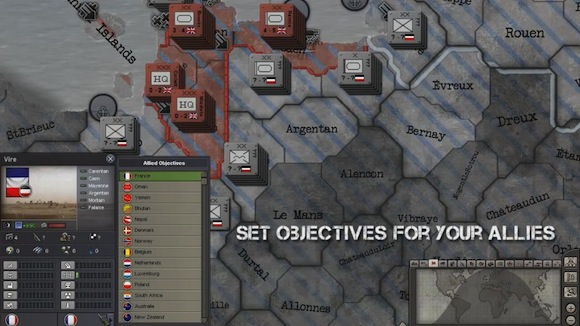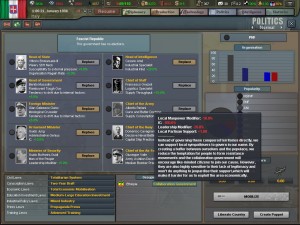aNewDomain.net — For most people, WWII games are nothing new. There are a plethora of strategy and first-person-shooter games that cover the history of the war. However, Paradox Interactive has developed a revolutionary and highly-detailed WWII strategy game known as Hearts of Iron III (H.O.I III). Released in 2009, Hearts of Iron III puts the player in the role of a national leader during WWII. It includes a huge number of historical elements like resource management, diplomacy, politics and of course, war planning.
The Devil is in the Details

One awesome feature of this game is that several countries are playable from the start. This lets players take over the world with tiny countries such as Mexico or Ethiopia. Traditional WWII games allow 5-7 playable nations; H.O.I III has more than 15 options.
From the gameplay it is clear that Paradox Interactive spent a ton of design time focused on authenticity. The campaign map mirrors a classic military planning board with authentic military unit symbols, and provinces are divided into cities and countries, which makes the player feel like every part of the map is important.
H.O.I III is riddled with micromanagement — you can control large fields like technology, military and agriculture, while managing seemingly insignificant features, such as draft laws and freedom of the press. I personally enjoy the micromanaging because it allows for a degree of role playing in a strategy-based game. It forces players like me to contemplate the strategy of war. What would Churchill do? What would Stalin do? Actually, maybe we shouldn’t contemplate Stalin, but it goes to show that even the most-mundane things could be the difference between victory and defeat.

Paradox Interactive, to my great enjoyment, personalized historic nations with authentic political parties, such as the Conservative Party of Great Britain and the dreaded National Socialist Workers Party (i.e. Nazi Party) of Germany. Paradox Interactive’s overdrive for detail even includes relatively unknown parties like the American Silver Legion. These parties make up the game’s sandbox-style political system where you can choose between the Allies, the Axis or the Comintern. This feature is one of my favorite perks about this game because it allows a player to create an alternate history while retaining depth and realism.
Another wonderfully diplomatic aspect of H.O.I III is the espionage feature. This allows one nation to send spies over to another nation in order to get the latter to join their alliance. For example, as the Soviet Union, I used my spies to increase Communist popularity in various Eastern European countries in order to win them over to the Comintern. It has a very nice mafia-style feel to it, and who doesn’t like James Bond-style spying and espionage?
What gives H.O.I. III a huge advantage above other WWII games, besides it’s authenticity and serious detail, is its highly-moddable game engine. The mods for this game engine expand the horizons of the vanilla (read, regular) version of the game, such as providing new countries, like India or Korea. For players like me, this is obviously a great add-on to the game. Who doesn’t like new nations and scenarios? One of the other great bonuses that pushes H.O.I. III over the top is a tutorial given by an animated Hitler, who hilariously commits suicide right after you complete the game.

The Downside
If there were any flaws to the game, I would have to say the graphics are lacking. Unfortunately, there are no “Saving Private Ryan”-style animations when your troops face battle. For me, a game isn’t complete when the troops lack a human face. In real life, those weren’t boxes and symbols on a map, they were real people fighting and killing each other. The visual content needed a way to make the war come alive.
Overall, I’d have to give this game a 9/10 for its high attention to detail, for its many cool features and for including so many realistic factors that shaped World War II.
Based in our data banks, Fegelein Puching Zhang is a gamer and valued contributor here at aNewDomain.net. His articles are interesting and reflect the viewpoint of … a mystery writer. Contact Fegelein at puching@anewdomain.net.














[…] Chicago, Fegelein Puching Zhang is our gaming scribe at aNewDomain.net. Read more of his work here or contact Fegelein […]
[…] Chicago, Fegelein Puching Zhang is our gaming scribe at aNewDomain.net. Read more of his work here or contact Fegelein […]
[…] in Chicago, Fegelein Puching Zhang is our gaming scribe at aNewDomain.net. Read more of his work here or contact Fegelein at […]
[…] Chicago, Fegelein Puching Zhang is our gaming scribe at aNewDomain.net. Read more of his work here or contact Fegelein […]
[…] in Chicago, Fegelein Puching Zhang is our gaming scribe at aNewDomain.net. Read more of his work here or contact Fegelein at […]
[…] Chicago, Fegelein Puching Zhang is our gaming scribe at aNewDomain.net. Read more of his work here or contact Fegelein […]
[…] Chicago, Fegelein Puching Zhang is our gaming scribe at aNewDomain.net. Read more of his work here or contact Fegelein […]
[…] in Chicago, Fegelein Puching Zhang is our gaming scribe at aNewDomain.net. Read more of his work here or contact Fegelein […]
[…] in Chicago, Fegelein Puching Zhang is our gaming scribe at aNewDomain.net. Read more of his work here or contact Fegelein […]
[…] in Chicago, Fegelein Puching Zhang is our gaming scribe at aNewDomain.net. Read more of his work here or contact Fegelein […]
[…] in Chicago, Fegelein Puching Zhang is our gaming scribe at aNewDomain.net. Read more of his work here or contact […]
[…] in Chicago, Fegelein Puching Zhang is our gaming scribe at aNewDomain. Read more of his work here or contact Fegelein […]
[…] in Chicago, Fegelein Puching Zhang is our gaming scribe at aNewDomain.net. Read more of his work here or contact Fegelein at […]